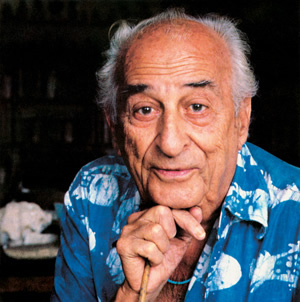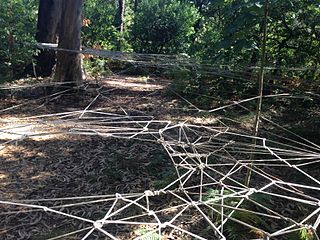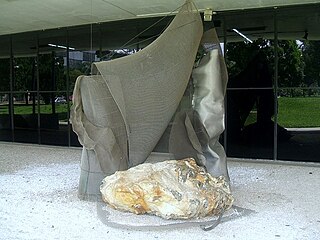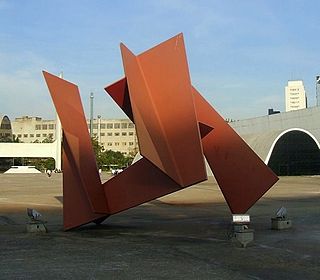Funk carioca, also known as favela funk and, in other parts in the world, baile funk and Brazilian funk, is a hip hop style from Rio de Janeiro, derived from Miami bass and gangsta rap music.
Brígida Baltar is a Brazilian visual artist. Baltar works with actions, sculpture and drawings among other media. She is interested in capturing the ephemeral in her artwork.

Héctor Julio Páride Bernabó or Carybé was an Argentine-Brazilian painter, engraver, draughtsman, illustrator, potter, sculptor, mural painter, researcher, historian and journalist. He settled in Brazil and naturalized as a Brazilian.

Abraham Palatnik was a Brazilian abstract artist and inventor whose innovations include kinechromatic art.

The creation of art in the geographic area now known as Brazil begins with the earliest records of its human habitation. The original inhabitants of the land, pre-Columbian Indigenous or Natives peoples, produced various forms of art; specific cultures like the Marajoara left sophisticated painted pottery. This area was colonized by Portugal in the 16th century and given the modern name of Brazil. Brazilian art is most commonly used as an umbrella term for art created in this region post Portuguese colonization.
Artur Barrio is an artist who lives and works in Rio de Janeiro, Brazil. Much of his work consists of installation pieces that create interaction with the public. Barrio engages the viewer as participant in his art, often without their knowledge that it is art in which they are participating. By doing so, the participant can have an experience not removed from life but rather incorporated into it. He wants to encourage contact with all of reality including the discards of life such as garbage. He wants us to recognize that this reality is just as real if we can see past the symbolic meanings we attach to these objects.
Rubens Gerchman was a Brazilian painter and sculptor. He was heavily influenced by concrete and neoconcrete art.
Cybèle Varela is a Brazilian mixed-media artist. She is a painter, video artist, and photographer.

Eliseu Visconti, born Eliseo d'Angelo Visconti was an Italian-born Brazilian painter, cartoonist, and teacher. He is considered one of the very few impressionist painters of Brazil. He is considered the initiator of the art nouveau in Brazil.
Frida Baranek is a Brazilian sculptor known for creating large sculptural works that incorporate fibers and industrial materials such as plates, rods, and iron or steel wires as commentary on industrialization and the environment in Brazil.

Fayga Perla Ostrower was a Polish-Brazilian engraver, painter, designer, illustrator, art theorist and university professor.
Regina Vater is a Brazilian-born American visual artist best known for her installation artwork inspired by Brazilian and African-Brazilian mythologies. In the 1960s, she designed the first album cover for the Tropicália movement, a Brazilian art movement associated with the Brazilian musicians Caetano Veloso and Gilberto Gil. In 1970, she had her first installation, "Magi(o)cean". She has conducted numerous interviews with John Cage, including a video interview that eventually became a part of her film Controverse. She moved to New York in the 1970s, and in 1979 she curated "the first and most comprehensive Brazilian avant-garde exhibit in the city at that time." In 1980, she was awarded a Guggenheim Fellowship. She lived in Austin, Texas with her husband, video installation artist and professor Bill Lundberg, until 2011, when they both moved to Rio de Janeiro, Brazil. Vater's work is known for its feminist themes and questions regarding culture and identity.
Anna Maria Maiolino is a Brazilian contemporary artist.

Fernanda Gomes is a Brazilian visual artist. She emerged as part of the generation of Rio de Janeiro-born artists that also include Beatriz Milhazes, Ernesto Neto and Adriana Varejão. With a career that began in the 1980s, her first solo exhibition took place in London in 1997.

Iole Antunes de Freitas is a Brazilian sculptor, engraver, and installation artist who works in the field of contemporary art. Freitas began her career in the 1970s, participating in a group of artists in Milan, Italy linked to Body art. She used photography. In the 1980s, she returned to Brazil, but abandoned the human body as mediator of her work, adopting the "sculpture body". The artist uses materials such as wire, canvas, steel, copper, stone, and water to create her works.
Waltércio Caldas Júnior, also known as Waltércio Caldas, is a Brazilian sculptor, designer, and graphic artist. Caldas is best known as part of Brazil's Neo-Concretism movement as well as for his eclectic choices in materials.

Franz Josef Weissmann was a Brazilian sculptor born in Austria, emigrating to Brazil while he was eleven years old. Geometric shapes, like cubes and squares, are strongly featured in his works. He was one of the founders of the Neo-Concrete Movement.

Brazil competed in the 2016 Summer Paralympics in Rio de Janeiro, as host country, from 7 September to 18 September 2016.
Neide Dias de Sá is a Brazilian artist who spent a big portion of her life teaching children art starting in the 1960s. Together with three others, she began an art movement in 1967 known as Poema/Processo. This art movement questioned the restraints that came with using words and replaced words with pictures. She did this years before pursuing a formal education in art. She did not earn her degree in graphic design until 1980.

Oskar Metsavaht is a Brazilian artist, academic degree in medicine, fashion designer environmental activist and Amazon guardian. Oskar's work expresses the theme of preserving the forest, water and the empowerment and protection of the peoples of the forest, as an artist, designer and activist. He is founder and creative director of Osklen, a Brazilian fashion brand, recognized as one of the forerunners of the New Luxury concept that strives for the fusion between ethics and aesthetics and advocates conscious fashion through the adoption of sustainable practices. Creative Director of OM.art studio, where he hosts his art studio, an exhibition space and the studio for the development and production of art projects. Metsavaht serves as UNESCO Goodwill Ambassador. Creator of Janeiro Hotel, located in Leblon, Rio de Janeiro. He is also on the Advisory Board of the Inhotim Institute and board member of Museum of Modern Art (MAM) of Rio de Janeiro. In 2014, Oskar Metsavaht was awarded as Knight of Ordem do Mérito Cultural medal from the Ministry of Culture (Brazil) an honorary order granted by the Federal Government to personalities and institutions that make relevant contributions to Brazil's culture.









